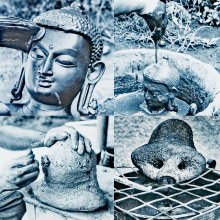Shade: 3 definitions
Introduction:
Shade means something in Hinduism, Sanskrit, Hindi. If you want to know the exact meaning, history, etymology or English translation of this term then check out the descriptions on this page. Add your comment or reference to a book if you want to contribute to this summary article.
Images (photo gallery)
In Hinduism
Vastushastra (architecture)
Source: Shodhganga: Elements of Art and Architecture in the Trtiyakhanda of the Visnudharmottarapurana (vastu)The Shade (of Trees) provides a recommended place for Stones that are used as a Material for the Construction of Temples, according to the Viṣṇudharmottarapurāṇa, an ancient Sanskrit text which (being encyclopedic in nature) deals with a variety of cultural topics such as arts, architecture, music, grammar and astronomy.—Finding of proper types of materials is one of the important aspects for any construction. Indian scriptures state that to procure the stones, the astrologer and the architect should go to mountain and examine the stones. The stone used in the Architecture of a temple should be [e.g., placed under the shade of trees , etc.]. In connection with temple building some specific colours of stones are also recommended.

Vastushastra (वास्तुशास्त्र, vāstuśāstra) refers to the ancient Indian science (shastra) of architecture (vastu), dealing with topics such architecture, sculpture, town-building, fort building and various other constructions. Vastu also deals with the philosophy of the architectural relation with the cosmic universe.
Shilpashastra (iconography)
Source: Shodhganga: Elements of Art and Architecture in the Trtiyakhanda of the Visnudharmottarapurana (shilpa)1) Different Shades of colours are created by the artists through the mixing of primary colours in the ancient Indian tradition of Painting (citra), according to the Viṣṇudharmottarapurāṇa, an ancient Sanskrit text which (being encyclopedic in nature) deals with a variety of cultural topics such as arts, architecture, music, grammar and astronomy. Mixing of colours is a great technique used by the artists to make numerous shades of colours. According to the Viṣṇudharmottarapurāṇa, a painter can create hundreds or thousands of colours by amalgamating the primary colours. [...] So, it can be said that, appropriate selection, proportion and distribution of colours are very necessary to get different shades of colours. The idea of which has been pointed out in the Viṣṇudharmottarapurāṇa.
2) The Shades of colours (in a painting) are conveyed through the concept of Varṇikābhaṅga, which represents one of the six limbs of Painting (citra), according to the Kāmasūtra and Viṣṇudharmottarapurāṇa.—[...] The last kind of limbs of Painting called varṇikābhaṅga is related to the colour differentiation of a Painting. In the Viṣṇudharmottarapurāṇa a detail discussion on the proper implementation of colours, narration on primary colours, different shades of colours are also found.

Shilpashastra (शिल्पशास्त्र, śilpaśāstra) represents the ancient Indian science (shastra) of creative arts (shilpa) such as sculpture, iconography and painting. Closely related to Vastushastra (architecture), they often share the same literature.
Languages of India and abroad
Hindi dictionary
Source: DDSA: A practical Hindi-English dictionaryShade in Hindi refers in English to:—(nm) a shade; shed..—shade (शेड) is alternatively transliterated as Śeḍa.
...
See also (Relevant definitions)
Starts with: Shade jhar, Shadendriyaprasadana, Shadevi.
Ends with (+14): African nightshade, American black nightshade, Ball nightshade, Bitter nightshade, Bittersweet nightshade, Black berry nightshade, Black nightshade, Climbing nightshade, Coiled-flower nightshade, Common nightshade, Cursed shade, Cut-leaved nightshade, Deadly nightshade, Eldorets nightshade, Fetid nightshade, Garden nightshade, Glossy nightshade, Greenspot nightshade, Indian nightshade, Lamp and shade.
Full-text (+403): Chaya, Anatapa, Vrikshacchaya, Adhvantashatrava, Pracchaya, Abhati, Savali, Atapabhava, Ashmantaka, Chayalakshana, Cikanasupari, Sacchaya, Citrapatra, Panic grass, Wood apple, Abhicchaya, Seda, Kemjaya, Chayashushka, Kembanna.
Relevant text
Search found 246 books and stories containing Shade; (plurals include: Shades). You can also click to the full overview containing English textual excerpts. Below are direct links for the most relevant articles:
Vinaya (3): The Cullavagga (by T. W. Rhys Davids)
Cullavagga, Khandaka 5, Chapter 23 < [Khandaka 5 - On the Daily Life of the Bhikkhus]
Cullavagga, Khandaka 7, Chapter 3 < [Khandaka 7 - Dissensions in the Order]
The Great Chronicle of Buddhas (by Ven. Mingun Sayadaw)
Part 2 - The Prince’s attainment of the First Ānāpāna Jhāna < [Chapter 2 - The Performance of the Ploughing Ceremony]
Part 1 - Changing the Mode of Practice < [Chapter 7 - The Attainment of Buddhahood]
Part 5 - Story of the Wandering Ascetic Sundari < [Chapter 25 - The Buddha’s Seventh Vassa]
The Pictorial Element in the Fiction of Thomas Hardy < [January – March, 1986]
Shadows & Shades < [July – September, 2005]
Truth at Day < [July – September, 2003]
Animal Kingdom (Tiryak) in Epics (by Saranya P.S)
Chapter 4.30 - The Kukkuta (Cocks) in the Epics
Chapter 4.9 - The Deer in the Epics
The Garuda Purana (by Manmatha Nath Dutt)
Chapter LXXI - Tests of Emerald < [Agastya Samhita]
Chapter LXXV - Tests of Karketana < [Agastya Samhita]
Chapter CCXXXIII - Naimittika Pralaya, etc. < [Dhanvantari Samhita]
Charaka Samhita (English translation) (by Shree Gulabkunverba Ayurvedic Society)
Chapter 5 - The Pathology of Dermatosis (kushtha-nidana) < [Nidanasthana (Nidana Sthana) — Section on Pathology]
Chapter 5 - Prognosis from premonitory symptoms (purvarupa) < [Indriyasthana (Indriya Sthana) — Section on Sensorial Prognosis]
Chapter 1 - Prognosis from voice and complexion (varna-svara) < [Indriyasthana (Indriya Sthana) — Section on Sensorial Prognosis]
Related products
(+1 more products available)







